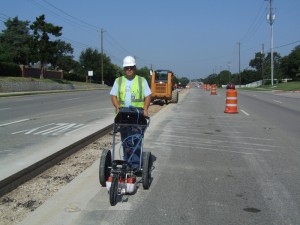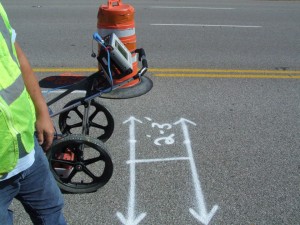PRIVATE UTILITY LOCATING
WOOD Inspection Services deploys traditional (EM) location equipment for the initial detection of visible utilities. Our team marks these lines with paint using the standard colors as defined by the Americas Public Works Association.
To be comprehensive, we scan the area with Ground penetrating radar for any signs of utilities or obstructions which should be avoided during excavation, digging or drilling. The data for is collected in a grid format which provides full coverage of the survey area and allows for unknown objects to be discovered. Next, a 3D map of the ground and its infrastructure can be developed. This is especially beneficial in congested areas for identifying utilities and also for pre-engineering purposes.
Underground Utility Locating Services
Utility Mapping and Surveying
Electromagnetic Locating (EML)
Ground Penetrating Radar (GPR)
Utility Verification
This involves verifying the existence and location of underground utilities that have been previously identified or mapped. This is typically performed prior to construction to ensure that utilities are properly located and avoid costly conflicts during the construction process.
SUE (Subsurface Utility Engineering) Services
- Quality Level A (QL-A)
- Quality Level B (QL-B)
- Quality Level C (QL-C)
- Quality Level D (QL-D)
Always Call Texas811
Call the public locator service in Texas, known as the the One-Call System (DIGTESS or 811). Do it before you dig, blast, bore, trench, drill, grade, or excavate underground in any way. If you hit a buried utility line, you could create a life-threatening situation and be fined and cause an outage to an essential utility service. Even if you have used the service before and you think you know where the underground utilities are, contact 811 before every digging project to protect yourself. Remember, it is a free service.
What Does the Public Locating Service Do?
Texas811 does not mark utilities, but instead notifies participating member utilities. In a few days, a representative of the utility will visit the property, locate and mark primary public utility lines (water lines, natural gas pipelines, electric). Before a visit to your property, white-line where you plan to dig, locators can more easily mark the affected utilities.
A reminder that utility maps are not updated often and the markings may be off. Texas811 has the most current, most accurate information about buried utilities.
Private vs. Public Utility Locating Companies
Understanding the difference between public and private utilities can be crucial when it comes to underground locating. Public utility services are those that end at the street, while private utilities are located between the meter and the building. It is important to note that Texas811 will not mark private or non-member utilities, which means that if you have a curbside meter or private utility lines, your property may not be marked for excavation. Other underground utilities that are generally not marked include sewer lines, private lighting, sprinkler systems, fire mains, secondary electric lines to detached garages, pools, and septic lines.
To ensure that all of your underground utilities are properly located and marked, it is important to contact an independent utility contractor like WOOD Inspection Services. Our team of experts can provide a comprehensive evaluation of both private and public utilities, as well as any unused lines on your property. We understand the importance of avoiding costly and dangerous mistakes during excavation, and we are committed to providing reliable and accurate information to help keep you and your property safe. To learn more about the difference between public and private utility services, please visit our private vs public utility services page.
Gallery


Frequently Asked Questions
Utility locator markings reveal what is underground, different colors identify different types of utilities. Charts from the APWA reveal what each color and marking defines from natural gas pipelines to sewer and water lines.
Locator flags are placed within paint marks as a warning. If you find flags outside the borders of locator markings, someone may have tampered with them. Contact Texas811 to confirm placement.
The tolerance zone is the width of an underground utility plus a specified tolerance distance on both sides of that utility. Do not use power-digging equipment within this zone. The zone provides a margin of error in case the locator marks are slightly off. It also provides a buffer zone to prevent damage resulting from nearby excavation.
If you do not respect the tolerance zone, you risk hitting buried utilities. You also risk damaging them indirectly by removing supporting soil, which could cause the utility to bend or break. You could be injured or killed, and your company could be liable for any damages that occur.
To avoid damaging buried utilities, do not power dig within the tolerance zone. Hand dig or use vacuum technology instead.
Public utilities are electric, gas, phone/cable, water and sewer lines managed by the city and utility companies (Verizon, Oncor, or Atmos)
The area of responsibility can vary by zip code, city and specific address. For example, some cities in DFW are responsible for the water service line from the street connection all the way to the meter. Other cities are only responsible from the street connection to the water shut off valve in the yard or at the property line. The rest of the line is considered private and becomes property of a homeowner or business owner.
Examples of Private Utilities
- Electric lines that go to outbuildings such as sheds, pole barns, garages, pools, etc.
- Gas lines that go to grills, pools, or outbuildings
- Phone/cable lines to outbuildings; water or sewer lines to outbuildings.
- A septic system, well, or irrigation system are also “private”.
Locating active utilities is dangerous, but important for many projects. For example a parking light might be an active utility, however not be active at the specific time of a survey because it’s switched or operating on a light sensor. WOOD Inspection Services can easily trace 60Hz power with utility locating equipment.
Some sewer and water line repair plumbers now deploy CCTV to locate breaks in utility lines. These cameras have a sonde pipe and cable locator built-in, which emits an electric signal. This signal can be read by a standard utility locator receiver.
In comparison, GPR mapping surveys the entire subsurface area and can reveal other obstructions: tree roots, old lines and more.
No marked utility is 100% accurate, even with the latest equipment and technology. We suggest a 2 feet leniency on either side of the marked lines to ensure safety. It should also be hand dug (or pot-holed) so that the utility can be safely verified.
Not everything is traceable. Anything plastic such as irrigation pipe or gas lines are not traceable unless there is a tracer wire that is laid with it. Fiber optic lines are glass and are difficult to be traced unless it has a tracer wire. Sanitary sewer lines typically aren’t traceable unless you can access a point of entry such as a clean out to run a traceable source into the line.
